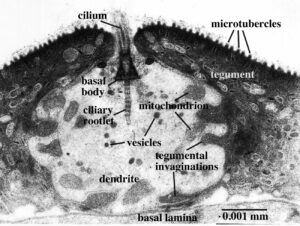Cilia are very minute structures that resemble a strand of hair that is present in the eukaryotic organisms. Their functions vary based on the location or cell they are present.
Do Animal Cells Have Cilia, Yes. Animal cells have cilia in them. Just like flagella, cilia is also present in animal cells. In multi-celled organisms, the function of cilia is to transport the cell or bodily fluids or any components in the system. In mammals, cilia is found in the respiratory tract (upper) for the protection of lungs.
Do all animal cells have cilia?
The function of cilia is based on the location they are present or it may vary by many factors.
Cilia is present in most of the animal cells but not in all animal cells.
Read more on Are Protists Eukaryotic.

Image Credits- Wikimedia
What are the different types of cilia?
Cilia are of 2 types
Motile cilia:
This type of cilia are present on the surface of the respiratory tract.
Non- motile cilia:
This type of cilia are called the primitive type of cilia that aid in the sensory signaling pathway like proper kidney functioning
Where is cilia in an animal cell?
Cilia can be motile cilia and non-motile cilia.
Cilia are usually found on the surface of the cell- all over and in numerous numbers. They are found in the epithelium layer in the respiratory tract which is called the respiratory epithelium in humans.
In humans, the cilia present in the epithelium (respiratory tract) aids in the clearance of mucus and other secretory components in the respiratory tract.
Read More on Do animal cells have vacuoles.
Explanation on structure of cilia:
Cilia are minute thread like structures.
Each minute thread is made up of Microtubules. Each contains 9 Microtubules in pairs as the outer ring and two polar microtubules in the center which is called as axonema.
The outer ring is made up of a protein (motor) called dynein.

Image credits- Wikimedia
Do all cells have cilia?
The cilia will be present in only certain cells which are supposed to have its function. So the answer is
No, Cilia is not present in all cells.
Do plant cells have cilia?
Plant cells are eukaryotic cells, so do they have cilia in them?
No, In general plant cells do not have cilia in them.
So all plant cells do not have cilia?- No.
Which plant cell has cilia?
All plant cells do not have cilia except one.
The cycad sperm cell contains cilia in it just like other sperm cells. Since this is the only plant cell that is ciliated, in general it is mentioned that plant cells do not have cilia but the cycad sperm cell do have a cilia in them.
Read more on Do humans have plant cell.
What is the Role of Channel Proteins in Active Transport in Animal Cells with Cilia?
Channel proteins play a crucial role in active transport within animal cells with cilia. These specialized proteins act as gateways, allowing specific molecules to enter or exit the cell. Through active transport, channel proteins use energy to move molecules against their concentration gradient, ensuring essential substances are transported to where they are needed. Cilia, with their hair-like structures, aid in the movement of the cell and enhance the efficiency of channel protein active transport.
Why don’t plant cells have cilia?
The intent of the organelle cilia and flagella is for motility.
Plant cells do not require moving. In addition, in animal cell these components aid in organizing the microtubules. In plant cell, they possess a very strong cell wall that keeps the microtubules intact during cell division thus not requiring cilia.
Function of cilia:
- The main function of cilia is that they aid in locomotion and also in the sensory function.
- They have a significant role in cell cycle, cell replication in animals and in humans.
- Cilia collectively move in a rhythmic motion that aid in the clearance of dirt and excess mucus or any antigenic molecule at that specific region.
- Non- motile cilia have a antenna like structure that aid in sensory function. They obtain information from the cells and signals the target.
- Example: Cilia in kidney cells aid in urine flow, the Cilia in the retina- photoreceptor aid in the flow of molecules from one terminal to another.
Also Read:
- Plant chromosomes structure
- Are proteins soluble
- Adenine and uracil bond
- Monophyletic group example
- Ribosomes and endoplasmic reticulum
- Smooth endoplasmic reticulum function
- Do plants have enzymes
- Facilitated diffusion vs active diffusion
- Does cell membrane produce energy
- Amylase enzyme example

Hello, I am Sugaprabha Prasath, a Postgraduate in the field of Microbiology. I am an active member of the Indian association of applied microbiology (IAAM). I have research experience in preclinical (Zebrafish), bacterial enzymology, and nanotechnology. I have published 2 research articles in an International journal and a few more are yet to be published, 2 sequences were submitted to NCBI-GENBANK. I am good at clearly explaining the concepts in biology at both basic and advanced levels. My area of specialization is biotechnology, microbiology, enzymology, molecular biology, and pharmacovigilance. Apart from academics, I love gardening and being with plants and animals.
My LinkedIn profile-